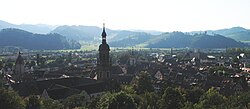Gengenbach Abbey
| Imperial Abbey of Gengenbach | ||||||||
| Reichskloster Gengenbach | ||||||||
| Imperial Abbey of the Holy Roman Empire | ||||||||
|
||||||||
| Capital | Gengenbach Abbey | |||||||
| Languages | Alemannic | |||||||
| Government | Elective principality | |||||||
| Historical era | Middle Ages | |||||||
| • | Founded | early 8th century | ||||||
| • | Granted to Bp Bamberg by Emperor Henry II |
1007 |
||||||
| • |
Gengenbach raised to Imperial city |
1360 |
||||||
| • | Gengenbach converted to Lutheranism |
1525 |
||||||
| • |
Augsburg Interim guaranteed Catholicism |
1548 |
||||||
| • | Unsuccessfully attempted to join College of Prelates |
1575 and 1580 |
||||||
| • | Joined College of Prelates | 1645 / 1751a | ||||||
| • | Mediatized to Baden | 25 February 1803 | ||||||
|
||||||||
| Today part of |
|
|||||||
| a: Accession to the College of Prelates approved in 1645, but not implemented until 1751. | ||||||||
Gengenbach Abbey (German: Kloster Gengenbach) was a Benedictine monastery in Gengenbach in the district of Ortenau, Baden-Württemberg, Germany. It was an Imperial Abbey from the late Carolingian period to 1803.
It was founded by Saint Pirmin (d. 735) sometime after his expulsion from Reichenau in 727 and settled by monks from Gorze Abbey. It enjoyed good relations with the Carolingian dynasty and soon became an Imperial abbey, with territorial independence. In 1007, however, Emperor Henry II presented it to his newly founded Prince-Bishopric of Bamberg. Whilst situated within the Ortenauer Reichslandvogtei, under the protection of Rudolph of Habsburg (1273–91), the territory's protectors were an array of local lords: the Zähringen were followed in 1218 by the Staufen dukes of Swabia and in 1245 by the bishops of Strasbourg until the 1550s. These Vögte and confirmations of their rights — both Papal (1139, 1235, 1252, 1287) and Imperial (1309, 1331, 1516) — ensured the Abbey's continual independence.
Gengenbach was deeply embroiled in the Investiture Controversy and two of its abbots were driven out for supporting the Imperial rather than the Papal cause. Shortly after this, the abbey was involved by Abbot Theoger (1080–1139) of St. George's Abbey in the Black Forest and Bishop Otto of Bamberg in the Hirsauer Reform, during which the abbey church was demolished and rebuilt to the Hirsau model. Subsequently, it has been remodelled in the Gothic, Baroque and neo-Romanesque styles.
...
Wikipedia

